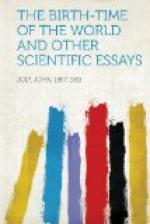86
present purpose, rate of consumption of energy, we proceed as follows:
{Fig. 1}
Along a horizontal axis units of time are measured; along a vertical axis units of energy. Then the life-history of the amoeba, for example, appears as a line such as A in Fig. 1. During the earlier stages of its growth the rate of absorption of energy is small; so that in the unit interval of time, t, the small quantity of energy, e1, is absorbed. As life advances, the activity of the organism augments, till finally this rate attains a maximum, when e2 units of energy are consumed in the unit of time.[1]
[1] Reference to p. 76, where the organic system is treated as purely mechanical, may help readers to understand what is involved in this curve. The solar engine may, unquestionably, have its activity defined by such a curve. The organism is, indeed, more complex; but neither this fact nor our ignorance of its mechanism, affects the principles which justify the diagram.
87
On this diagram reproduction, on the part of the organism, is represented by a line which repeats the curvature of the parent organism originating at such a point as P in the path of the latter, when the rate of consumption of energy has become constant. The organism A has now ceased to act as a unit. The products of fission each carry on the vital development of
{Fig. 2}
the species along the curve B, which may be numbered (2), to signify that it represents the activity of two individuals, and so on, the numbering advancing in geometrical progression. The particular curvature adopted in the diagram is, of course, imaginary; but it is not of an indeterminate nature. Its course for any species is a characteristic of fundamental physical importance, regarding the part played in nature by the particular organism.
88
In Fig. 2 is represented the path of a primitive multicellular organism before the effects of competition produced or fostered its mortality. The lettering of Fig. 1 applies; the successive reproductive acts are marked P1, P2; Q1, Q2, etc., in the paths of the successive individuals.
{Fig. 3}
The next figure (Fig. 3) diagrammatically illustrates death in organic history. The path ever turns more and more from the axis of energy, till at length the point is reached when no more energy is available; a tangent to the curve at this point is at right angles to the axis of energy and parallel to the time axis. The death point is reached, and however great a length we measure along the axis of time, no further consumption of energy is
89
indicated by the path of the organism. Drawing the line beyond the death point is meaningless for our present purpose.
It is observable that while the progress of animate nature finds its representation on this diagram by lines sloping upwards from left to right, the course of events in inanimate nature—for example, the history of the organic configuration after death, or




